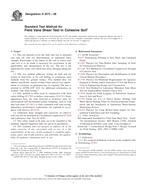Potrebujeme váš súhlas na využitie jednotlivých dát, aby sa vám okrem iného mohli ukazovať informácie týkajúce sa vašich záujmov. Súhlas udelíte kliknutím na tlačidlo „OK“.
ASTM D2573-08
Standard Test Method for Field Vane Shear Test in Cohesive Soil
Automaticky preložený názov:
Štandardná skúšobná metóda pre Field Vane šmyku Test na Cohesive pôdy
NORMA vydaná dňa 1.10.2008
Informácie o norme:
Označenie normy: ASTM D2573-08
Poznámka: NEPLATNÁ
Dátum vydania normy: 1.10.2008
Kód tovaru: NS-20786
Počet strán: 8
Približná hmotnosť: 24 g (0.05 libier)
Krajina: Americká technická norma
Kategória: Technické normy ASTM
Anotácia textu normy ASTM D2573-08 :
Keywords:
clay, exploration, in-situ test, sensitivity, shear strength, undrained strength, vane shear, Cohesive soils, Field testing--soil, Field vane shear test, In-situ soil/rock testing/analysis, Shear testing--soil, Soil, Vane shear test, ICS Number Code 93.020 (Earth works. Excavations. Foundation construction. Underground works)
Doplňujúce informácie
| Significance and Use | ||||||||||||||||||||
|
This test method provides an indication of in-situ undrained shear strength of fine- grained clays and silts or other fine geomaterials such as mine tailings, organic muck, and substances where undrained strength determination is required. The test is applicable to soils with undrained strengths of less than 200 kPa (2 tsf). Very sensitive soils can be remolded during vane insertion. This test method is used extensively in a variety of geotechnical explorations to evaluate rapid loading strength for total stress analysis of saturated fine-grained clays and silts. The test is routinely performed in conjunction with other field and laboratory tests. The peak undrained shear resistance of the vane test is commonly corrected to determine the undrained shear strength for geotechnical analysis. The agency requesting the testing must interpret these data to determine applicability for strength analysis. It is beyond the scope of this standard to recommend applicability of vane testing for geotechnical analysis. For information on the general use of these correction factors, consult Appendix X1. This method is not applicable in sands, gravels, or other high permeability soils. With the shearing rates described in this standard, sand lenses, if present, will allow total or partial drainage. Soils with higher permeability, in rapid shear, can dilate or collapse and generate negative or positive pore pressures which may, or may not, dissipate in the shearing process. It is important to check the soil type being tested. It is very beneficial to sample the soil either before or after testing, to understand the drainage conditions (permeability) of the soil tested. This test is often performed in drilled boreholes or with self-push or self-drilling or pushed (vane shoe) methods. This method also applies to hand held vane shear tests performed at shallow depths, however, hand held equipment may be less accurate, because it may be more difficult to maintain vane/rod stability and verticality. Note 2—The quality of the result produced by this standard is dependent on the competence of the personnel performing it, and the suitability of the equipment and facilities used. Agencies that meet the criteria of Practice D 3740 are generally considered capable of competent and objective testing. Users of this standard are cautioned that compliance with Practice D 3740 does not in itself assure reliable results. Reliable results depend on many factors; Standard Practice D 3740 provides a means of evaluating some of those factors. |
||||||||||||||||||||
| 1. Scope | ||||||||||||||||||||
|
1.1 This test method covers the field vane test in saturated clay and silt soils for determination of undrained shear strength. Knowledge of the nature of the soil in which each vane test is to be made is necessary for assessment of the applicability and interpretation of the test. The test is not applicable for sandy soils which may allow drainage during the test. 1.2 This test method addresses testing on land and for testing in drill holes or by self drilling or continuous push methods from the ground surface. This method does not address specifically marine testing where special test requirements or variations in equipment may be required. The user is referred to ASTM STP 1014 for additional information on in-place vane shear testing. 1.3 This method is often used in conjunction with fluid rotary drilling (D 5783) or hollow-stem augers (D 6151). Some apparatuses have the vane retracted in protective shoe for advancement and incremental testing. Sampling, such as with thin wall tubes (D 1587) is often combined with vane testing. Subsurface geotechnical explorations are reported in accordance with practice (D 5434). 1.4 Undrained shear strength and sensitivity of cohesive soils can also be measured in Unconfined Compression D 2166 and Laboratory Vane Test (D 4648). 1.5 The values stated in SI units are to be regarded as the standard. English (Imperial) units are given in parentheses. 1.6 This standard does not purport to address all of the safety concerns, if any, associated with its use. It is the responsibility of the user of this standard to establish appropriate safety and health practices and determine the applicability of regulatory limitations prior to use. |
||||||||||||||||||||
| 2. Referenced Documents | ||||||||||||||||||||
|
Odporúčame:
Aktualizácia technických noriem
Chcete mať istotu, že používate len platné technické normy?
Ponúkame Vám riešenie, ktoré Vám zaistí mesačný prehľad o aktuálnosti noriem, ktoré používate.
Chcete vedieť viac informácií ? Pozrite sa na túto stránku.




 Cookies
Cookies
